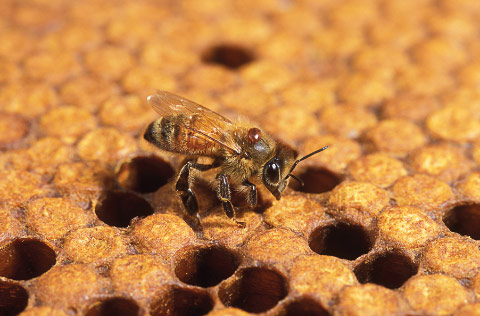The Honey Bee Puzzle
IPM Experts Look for Ways to Keep Colonies Healthy
 |
|
Brooding over solutions . . . IPM scientists study mites, viruses, pesticides, bee reproduction, and beneficials in search of clues to colony collapse. ARS photo by Stephen Ausmus. |
In 2006, managed honey bee colonies began to disappear in large numbers without known reason. Scientists suspect this problem may be caused by a complex combination of factors, including disease, parasites, pesticides, and other environmental stresses. The Northeastern IPM Center has supported projects that boost our understanding of honey bee colony health, investing nearly $350,000 in related research since 2003. These studies add to the knowledge base that could help us protect honey bees, which directly and indirectly pollinate one-third of the foods we eat.
Since the 1980s, bee colonies have been extensively damaged by a pest called the varroa mite. Dennis vanEngelsdorp (Pa. Dept. of Agriculture) tested the effectiveness of two biopesticides, formic and oxalic acids, which are used to control varroa in Canada and Europe but have not been approved for use in the United States. In this country, beekeepers use conventional pesticides to control mites, but the pests show increasing resistance to these materials. Moreover, beekeepers are concerned about impacts of pesticides on bees and bee products.
Results of vanEngelsdorp’s study showed that certain uses of organic acids can effectively suppress mite populations below the economic threshold. If organic acids were developed into registered products for American beekeepers, they might provide more economical mite management, reduce pesticide residues in bee products, and slow the development of mite resistance to conventional pesticides.
Penn State’s Nancy Ostiguy has explored interruption of bee reproduction as a way of reducing levels of varroa mites, which require bee broods to reproduce. Ostiguy temporarily removed or isolated queens from the rest of the colony to prevent reproduction. Early results showed only minor differences in mite populations when brood production was interrupted, but Ostiguy also noticed very high levels of queen replacement by the colonies.
A closer look revealed a significant relationship between viral infection and queen replacement. In fact, colonies with the highest virus levels requeened themselves most frequently. Varroa, a vector of bee viruses, may be a factor in this equation, too. Ostiguy was able to show, for the first time, the transmission of a virus to honey bee larvae via honey and pollen. Some viruses may contaminate pollen even before honey bee contact.
“These data are extremely important,” Ostiguy explains, “because they may provide clues as to why queen quality has declined since the introduction of the varroa mite.”
John Burand (Univ. of Mass.) is leading a multistate team to develop diagnostic tools for assessing bee colony health. By examining pathogens at the molecular level, Burand seeks a better understanding of microflora that enhance bee health. He hopes to translate this new knowledge into IPM recommendations that will help to maintain the microbes which are beneficial to bees.
— by ELIZABETH MYERS
The Northeastern IPM Center promotes integrated pest management for reducing risks to human health and the environment. If republishing our news, please acknowledge the source (“From Northeast IPM Insights”) along with a link to our website.
